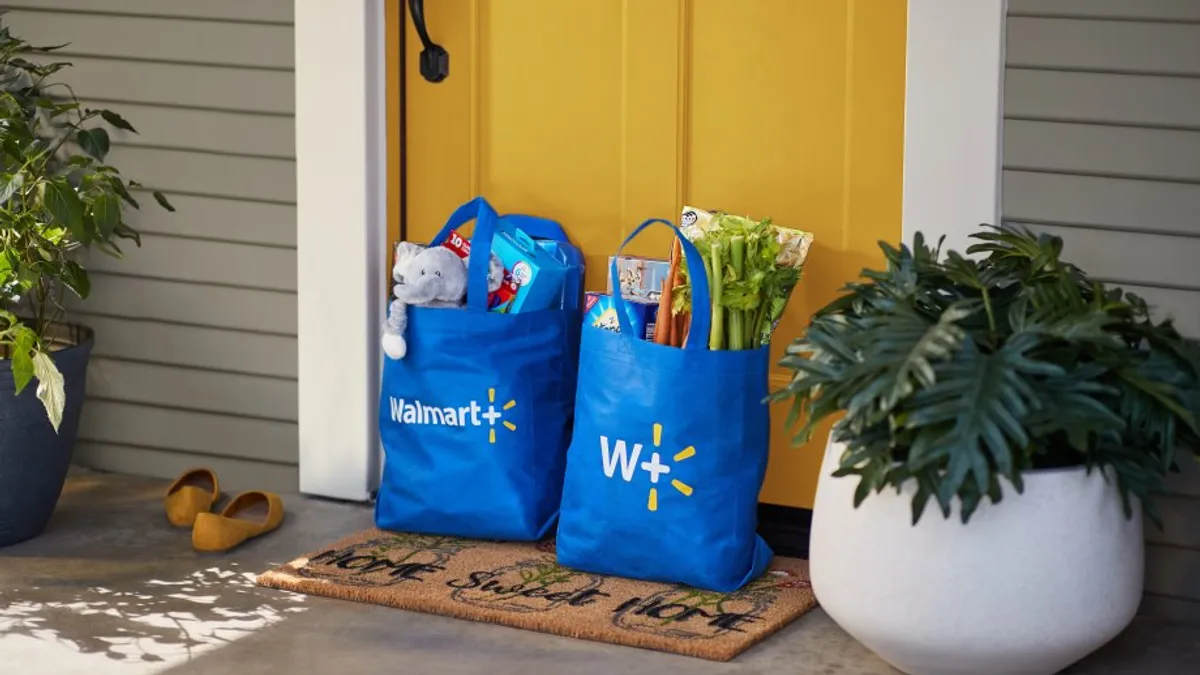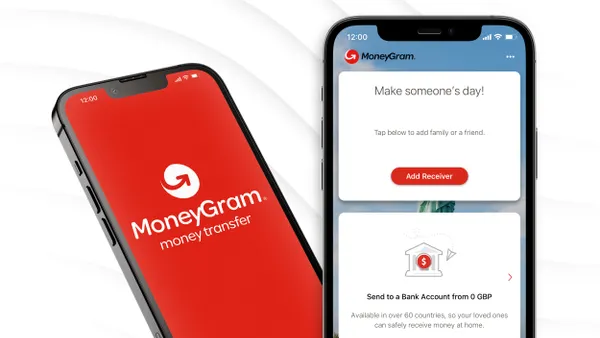After multiple attempts to get into the subscription business, Walmart gave it another go when it launched Walmart+ in September. And this time, not only has it hit the right formula, analysts think; it's coming at the right time. By launching during the pandemic and riding the accompanying e-commerce acceleration, the company is positioning itself to become the omnichannel juggernaut it's long wanted to be.
For taking that strategic risk, Walmart is CFO Dive's Company of the Year.
"Omnichannel ... is what we're focused on," says Brett Biggs, the company's executive vice president and CFO. "We've been so successful as a store company. [Now], over the last several years, we've gotten bigger into e-commerce, and the ability to put these things together allows us to give the customer the chance to shop in a seamless fashion. That's what we want to do."
The company's omnichannel strategy is about giving consumers the ability to access Walmart's low prices and wide selection in whatever way suits them best: at one of the company's 4,700 super centers, online, or for pick-up or home delivery. The subscription service, which is the loyalty rewards piece of that strategy, was intended to launch in April but the company pulled back to gauge the impact of the pandemic.
What it learned during the pause was that its customers, although tending to be older and accustomed to brick-and-mortar shopping, were willing to make the switch to online.
The company saw a 97% increase in its e-commerce sales in the second quarter and, while those sales only comprise 5% of online commerce in the United States, it's enough to make it the biggest competitor to industry leader Amazon, which commands about 40% of the market.
"Our strategy of being an omnichannel retailer, with stores and having e-commerce, we've always thought was the right strategy and now it's clearly the right strategy," Biggs said. "Customers want to be in stores, but they're also going to want to shop online."
Investors are responding to the effort. The company's stock valuation hit 145.21, a high, in early November, up from about 137 before it launched the program.
"Walmart invested a ton of money, and had given up a third of their operating income for e-commerce business, and investors are rewarding them," Bill Simon, Walmart's CEO from 2010 to 2014, told CNBC.
Groceries to drive merchandise sales
The core of Walmart's subscription strategy is to leverage the power of its grocery sales, for which it has a large and systemic advantage over Amazon and other online retailers, to drive sales of general merchandise — where real profitability lies.
"As families spent more time at home, we saw strong increases in categories like home, sporting goods, landscape, and electronics," Biggs said in the company's most recent earnings call.
Under Walmart+, consumers pay $12.95 a month, or $98 a year, for free delivery of groceries and general merchandise ordered online, fuel discounts at its super center gas stations, and in-store access to an app that lets them pay for their purchases on their phone and skip the checkout line. Other benefits will roll out over time.
"We'll add some things to it beyond just delivery," Doug McMillon, Walmart's CEO, said in the company's latest earnings call. "Building repeat [customers] is going to be an important aspect for the company to focus on. We'll also get the benefits of data and learn how to serve customers more effectively."
With its initial focus on free delivery, analysts see the move primarily as a launching pad for competing against Amazon Prime, which was introduced in 2005 and costs consumers $117 a year. More than 80% of Prime customers say free and fast delivery is their main reason for subscribing, and that's fueling the program's 95% annual renewal rate, analysts say.
But Simon says the Prime comparison misses the mark; Walmart+ is about using its grocery sales to sell more higher-profit merchandise, not going toe-to-toe with Amazon.
"Really, what Walmart is trying to do, and it's been their secret sauce, particularly with the super centers, is to try to take the traffic, in this case clicks, they generate from their really robust food business and sell general merchandise," he said.
"You don't have to be as good as Amazon," says Charlie O'Shea, senior retail analyst at Moody's Investor Services.
Mixed record
Walmart is one of the largest companies in the world by revenue — $524 billion in fiscal year 2020 — and the largest private employer, with 2.2 million workers. But it hasn't always fared well online, despite its resources.
It bought movie streaming service Vudu in 2010 to compete with Netflix, but sold it after lackluster success. It bought online marketplace Jet.com in 2016 only to discontinue it this year, leaving it with 50,000 vendors on its site compared to Amazon's eight million. And in 2017, it spent $16 billion to buy Flipkart, India's big online marketplace, but it remains to be seen whether that will bring success.
"Vudu didn't turn into much, Jet is gone already, and it's too early to tell on Flipkart," Simon said.
The company's next tech purchase could be the U.S. operations of TikTok, which Walmart offered to buy in partnership with Oracle after President Trump this year threatened to ban it on national security grounds. That proposal is pending, but it would be another example of the risks the company is willing to take to move beyond its retail store origins.
"You've got to give them credit for being aggressive in this space," Simon said.
Surprising nimbleness
Andreas Schulmeyer, a veteran CFO who Walmart hired in 2008 to manage the finances of the team launching the company's first e-commerce site, credits executives for recognizing the need to give their online approach a startup culture.
"The luxury of working in a company like Walmart is you can really experiment with things and figure out how to make them work," he said. "That was one of the enticements for me to come over. We were effectively starting up a new e-commerce business with one of the biggest funds behind us."
Not only did the company let the team set up in Silicon Valley rather than its Bentonville, Arkansas, headquarters, Schulmeyer said, it gave them internal finance and operational flexibility it never would have allowed on the traditional retail side.
"Walmart is very used to counting nuts and bolts," he said. "But what's the life of software? How much did it cost to build? If you know engineers in Silicon Valley, they will never give you how many hours they worked on which project. So, it was impossible to build that level of detail on how much the software was actually on the books for, piece by piece, but what I could give them was the overall picture."
Schulmeyer said he was able to get Walmart's controller to agree to an accounting method in which the e-commerce affiliate would list in aggregate the software under development based on the expected life span of each application, whether that was less than a year, up to three years, and so on.
"We said, ‘Let us build the software we need to and we just report it that way, which gives you, according to the accounting rules, a good representation of our assets as they are on the books at this point,'" he said. "‘But if you ask us to track each piece individually, I'm going to lose a bunch of engineers who are going to walk out the door. So you've got to make a choice as the controller team. How tight do you want those controls? What are you willing to live with so that we can build the software that we need to, and you get the accounting that we agree meets the requirements of GAAP on measuring the assets we have?'"
All of that flexibility, he said, the company granted.
Path ahead
Despite its mixed success online, the company has become the main competitor to Amazon, and although executives say their focus is on their omnichannel strategy and not becoming the online sales leader, their size gives them the resources to make a go of it.
Their willingness to experiment, as they're doing with their subscription program, suggests they might have the right culture, too, despite their traditional roots.
"The financial strength of the company allows us to focus on our core brick-and-mortar business and e-commerce business," Biggs said in a discussion hosted by the University of Texas. "But at the same time, it allows us to invest to set this company up for 50 years from now. The ability to invest for now and the future is a luxury some companies don't have."




 Read more
Read more









